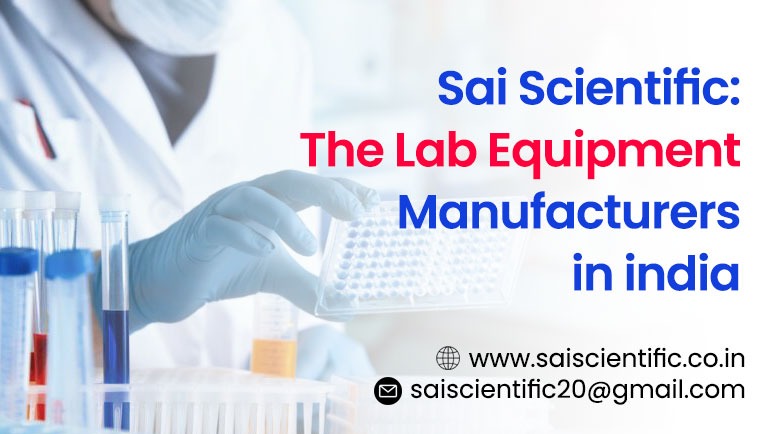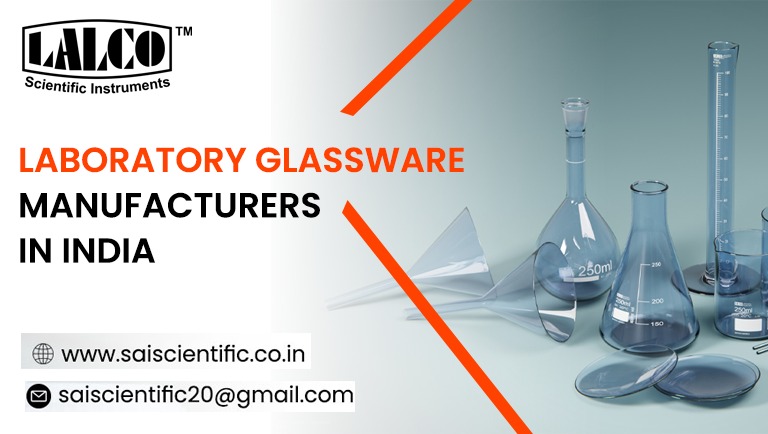Sai Scientific Laboratory equipment is essential for conducting experiments, measurements, and research in scientific fields such as chemistry, biology, and physics. With its own manufacturing facilities, professional management a commitment to quality & customer satisfaction and almost two decades of experience, we are fully capable of meeting the demands & requirements of customers all over the world.
Get in touch with us
Address:
# 24,VIKAS PURI, NEAR SAI BABA MANDIR POST OFFICE INDUSTRIAL AREA AMBALA CANTT-133001 HARYANA (INDIA)
Call Us:+91 98960-02169
Website: https://saiscientific.co.in/
Below is a detailed list of common laboratory equipment along with their uses:
1. Glassware & Plasticware
a) Beaker
Use: Used to hold, mix, and heat liquids. It has a wide mouth and a spout for easy pouring.
b) Erlenmeyer Flask (Conical Flask)
Use: Used for mixing, heating, and storing liquids. The narrow neck minimizes evaporation and spillage.
c) Volumetric Flask
Use: Designed for precise measurement of specific liquid volumes. It is commonly used in preparing solutions of exact concentrations.
d) Test Tube
Use: Used to hold small amounts of substances for chemical reactions, heating, and mixing.
e) Graduated Cylinder
Use: Used to measure liquid volume accurately. It has graduation marks to indicate different volume levels.
f) Burette
Use: Used in titrations to deliver precise volumes of a liquid reagent. It allows controlled addition of liquids.
g) Pipette
Use: Used to transfer small volumes of liquid accurately. Comes in different types:
- Volumetric Pipette – Measures and delivers a single, specific volume.
- Micropipette – Used for extremely precise measurement of very small liquid volumes.
h) Petri Dish
Use: Used for culturing bacteria, fungi, and other microorganisms in microbiology labs.
i) Watch Glass
Use: Used to hold small samples, evaporate liquids, or cover beakers.
j) Funnel
Use: Helps transfer liquids into narrow-mouthed containers to avoid spills. Also used for filtration.
k) Reagent Bottle
Use: Used to store chemical solutions, acids, and bases safely.
2. Heating Equipment
a) Bunsen Burner
Use: Provides a single open flame for heating substances in test tubes, beakers, or crucibles.
b) Hot Plate
Use: Used to heat substances evenly, especially when direct flame is not ideal.
c) Water Bath
Use: Used for heating samples at a controlled temperature without direct contact with a flame.
d) Heating Mantle
Use: Used to heat flammable liquids evenly without open flames.
e) Crucible and Lid
Use: Used for heating substances at high temperatures, often for melting or decomposing solid materials.
3. Measuring Instruments
a) Analytical Balance
Use: Used to measure small masses with high precision (up to 0.0001g).
b) Triple Beam Balance
Use: A less precise balance used for measuring mass in general lab work.
c) Thermometer
Use: Measures temperature of liquids, gases, or solid substances in experiments.
d) pH Meter
Use: Measures the acidity or alkalinity of a solution.
e) Spectrophotometer
Use: Measures the absorbance of light by a sample to determine concentration.
f) Conductivity Meter
Use: Measures the electrical conductivity of a solution, often used in water quality testing.
g) Refractometer
Use: Measures the refractive index of a liquid to determine concentration or purity.
h) Manometer
Use: Measures gas pressure in closed systems.
4. Microscopy & Imaging
a) Compound Microscope
Use: Used for magnifying small specimens like bacteria, cells, and tissue samples.
b) Stereo Microscope
Use: Provides a 3D view of larger specimens, such as insects or plant parts.
c) Electron Microscope
Use: Uses electron beams instead of light to achieve much higher magnification for studying cell structures and nanoparticles.
d) UV Transilluminator
Use: Used in molecular biology labs to visualize DNA, RNA, or proteins after gel electrophoresis.
5. Laboratory Safety Equipment
a) Fume Hood
Use: Removes hazardous chemical fumes and vapors from the lab to ensure safe air quality.
b) Safety Goggles
Use: Protects eyes from chemical splashes and flying debris.
c) Lab Coat
Use: Protects clothing and skin from spills and splashes.
d) Gloves
Use: Protects hands from hazardous chemicals, heat, and contamination.
e) Eyewash Station
Use: Provides immediate rinsing in case of chemical exposure to the eyes.
f) Fire Extinguisher
Use: Used to put out laboratory fires. Different types exist for electrical, chemical, and combustible material fires.
6. Miscellaneous Lab Equipment
a) Mortar and Pestle
Use: Used for grinding and mixing solid substances into fine powder.
b) Desiccator
Use: Used to store moisture-sensitive materials to keep them dry.
c) Centrifuge
Use: Used to separate substances of different densities using rapid spinning motion. Common in medical and biochemical labs.
d) Incubator
Use: Provides controlled temperature conditions for growing microbial or cell cultures.
e) Autoclave
Use: Uses high-pressure steam to sterilize lab equipment and biological materials.
f) Laminar Flow Hood
Use: Provides a sterile, particle-free environment for working with sensitive biological materials.
g) Chromatography Apparatus
Use: Used for separating components of a mixture based on their movement through a medium.
h) Electrophoresis Apparatus
Use: Used in molecular biology to separate DNA, RNA, or proteins based on size and charge.
i) Tongs and Forceps
Use: Used for handling hot, delicate, or hazardous substances.


